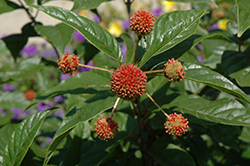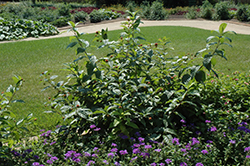Plant Finder
Height: 5 feet
Spread: 5 feet
Sunlight:
![]()
![]()
Hardiness Zone: 4b
Other Names: Button Willow, Honey Bells
Description:
An interesting shrub with most unusual flowers, fuzzy white balls that hang at the end of stalks, makes a good conversation piece when in bloom; otherwise, no spectacular ornamental attributes; an excellent choice for very wet sites
Ornamental Features
Button Bush features unusual creamy white ball-shaped flowers along the branches from early to late summer. It has green deciduous foliage. The pointy leaves do not develop any appreciable fall color.
Landscape Attributes
Button Bush is a multi-stemmed deciduous shrub with a more or less rounded form. Its average texture blends into the landscape, but can be balanced by one or two finer or coarser trees or shrubs for an effective composition.
This shrub will require occasional maintenance and upkeep, and is best pruned in late winter once the threat of extreme cold has passed. It has no significant negative characteristics.
Button Bush is recommended for the following landscape applications;
- General Garden Use
- Naturalizing And Woodland Gardens
Planting & Growing
Button Bush will grow to be about 5 feet tall at maturity, with a spread of 5 feet. It tends to fill out right to the ground and therefore doesn't necessarily require facer plants in front, and is suitable for planting under power lines. It grows at a fast rate, and under ideal conditions can be expected to live for approximately 20 years.
This shrub does best in full sun to partial shade. It prefers to grow in moist to wet soil, and will even tolerate some standing water. It is not particular as to soil type or pH. It is highly tolerant of urban pollution and will even thrive in inner city environments. This species is native to parts of North America.





